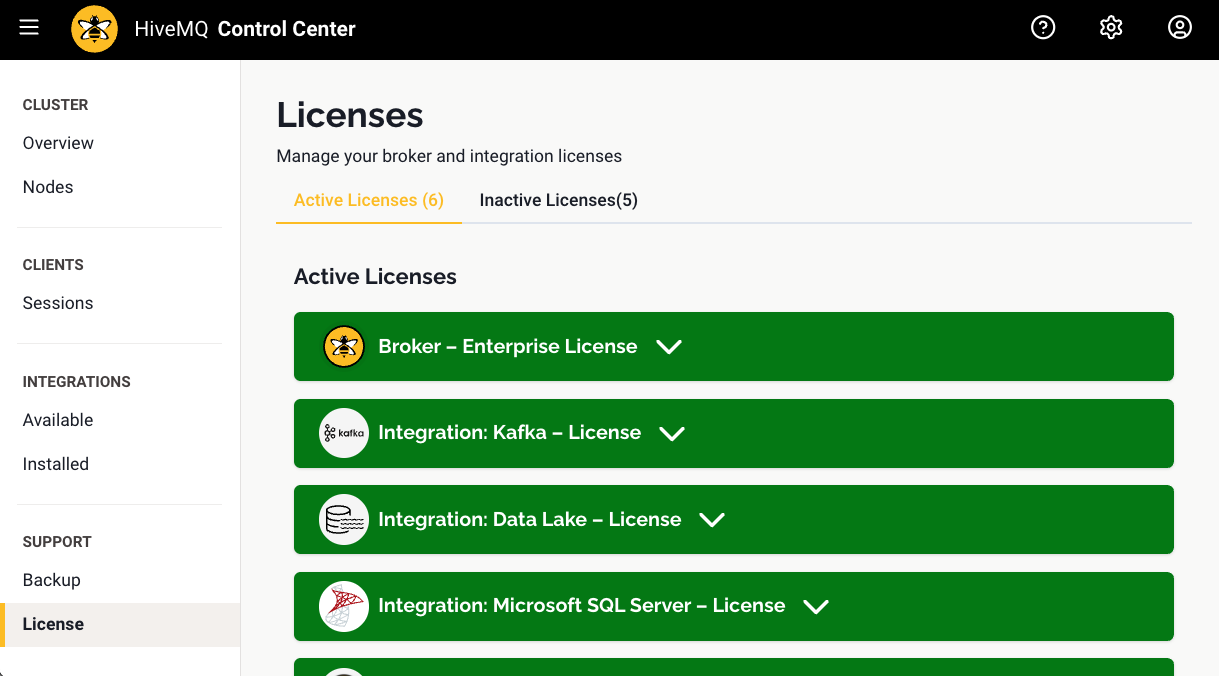HiveMQ Control Center v2: Licenses View
Your HiveMQ instance can contain multiple licenses. The Licenses view of the HiveMQ Control Center provides a comprehensive list of all licenses available in the license folder of your installation.

Active Licenses
The Active Licenses tab of the Control Center License view shows the main broker license that is in use. The HiveMQ Broker entry indicates the edition type the license enables. For example, Enterprise. If no broker license is present, a trial license is displayed.
The Active Licenses list also displays available HiveMQ Enterprise Integration licenses and any custom licenses you have added.
Active Licenses Details
To expand detailed information for a license, select the arrow next to the license name.
| Item | Description |
|---|---|
Connections |
The number of concurrent client connections currently in use and the maximum number of connections the active license allows. |
CPU Cores |
The number of CPU cores currently in use and the maximum number of cores the active license supports. |
Cluster Nodes |
The number of cluster nodes currently in use and the maximum number of cluster nodes the active license supports. |
Cluster License |
Indicates whether the license enables the use of HiveMQ clusters. |
License Type |
The type of HiveMQ edition the license enables. |
Filename |
The filename of the current license. |
License Start Date |
The date on which the license was activated. |
License Expiration Date |
The expiration date of the license that is currently in use. |
License Owner |
The owner of this license. |
Contact |
Contact information for the owner of the license. |
Email address of the owner of the license. |
Show Features for Active License
To view a list of all the features the selected active license includes, expand the Show Features option.
When selected, the Show Features option in the Active License area indicates all the HiveMQ features that your active HiveMQ license enables and further information for each.
| Feature | Description |
|---|---|
Backup and Restore |
Provides mechanisms to ensure minimum loss and quick recovery from potentially disastrous situations. |
Client Event History |
Adds fine-grained per-client observability to the HiveMQ Control Center and provides a historical view of client events. |
Configurable Connect Overload Protection |
Allows you to enable, disable, and configure your connect overload protection to control the rate of MQTT |
Control Center Audit Log |
Adds a record of all administrative actions that occur in your HiveMQ Control Center to provide a single, unified log for tracking auditing-relevant data. |
Control Center Clients View |
Provides information on subscriptions, connection status, TLS, and more to give you detailed insights into every client on your HiveMQ installation. |
Control Center Dropped Messages View |
Provides the tools to track all dropped messages in your HiveMQ cluster. |
Control Center Retained Messages View |
Provides the tools to track and manage all the retained messages in your HiveMQ cluster, including detailed information on each retained message. |
Control Center Shared Subscriptions View |
Provides a snapshot of all shared subscriptions on your HiveMQ cluster. |
Data Hub Data Validation |
Adds the ability to validate messages based on the structure of the message content and control the flow of messages through your HiveMQ broker accordingly. |
Encrypted Cluster Communication |
Enables the use of a secure TLS connection to provide encrypted communication between the nodes of your HiveMQ cluster. |
Fine-grained Control Center Permissions |
Adds the ability to define access to all pages of your control center and to all control center functionality. For more information, see Control Center Access Control. |
Fine-grained REST API Permissions |
Allows you to implement fine-grained access control for the HiveMQ REST API. For more information, see REST API Permissions. |
MQTT Add-on Dead Topic |
Adds a special analytical MQTT topic that you can use to automatically collect detailed information for all dead MQTT messages on your HiveMQ system. |
MQTT Add-on Dropped Topic |
Adds a special analytical MQTT topic that you can use to automatically collect detailed information for all dropped MQTT messages on your HiveMQ system. |
MQTT Add-on Expired Topic |
Adds a special analytical MQTT topic that you can use to automatically collect detailed information for all expired MQTT messages on your HiveMQ system. |
Native SSL |
Enables the use of the HiveMQ native SSL implementation. |
OCSP Stapling |
Allows the HiveMQ broker, rather than the client, to make status requests to the OCSP responder. |
PROXY Protocol |
Allows the transportation of client details such as the IP address and port over multiple proxies. |
REST API |
Provides an interface for applications to interact programmatically with the HiveMQ Enterprise MQTT broker. |
SSL Handshake Throttling |
Allows you to limit the number of SSL handshake operations the HiveMQ broker allows per listener. |
Trace Recordings |
Allows you to track the messages of specific clients or topics and review the information in a human-readable format. For more information, see Trace Recordings. |
Inactive Licenses
The Inactive Licenses tab lists all inactive licenses for which information is available.
To view detailed information for a license and the reason the license is inactive, select the arrow next to the license name.
Trial License
If no license is installed in the license folder of your HiveMQ installation, HiveMQ automatically uses a free trial license. Trial licenses are limited to 25 concurrent connections and are not intended for production use.
If your license expires, a trial license is used automatically. Information on the expired license appears in the Inactive Licenses area.
To view a list of the features the trial license includes, expand the Show Features area.